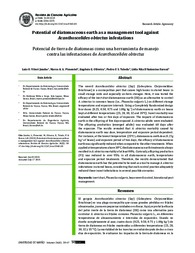Potential of diatomaceous earth as a management tool against Acanthoscelides obtectus infestations.
Potential of diatomaceous earth as a management tool against Acanthoscelides obtectus infestations.
Author(s): JUMBO, L. V.; PIMENTEL, M. A. G.; OLIVEIRA, E. G.; TOLEDO, P.; FARONI, L. R. D'A.
Summary: The weevil Acanthoscelides obtectus (Say) (Coleoptera: Chrysomelidae: Bruchinae) is a cosmopolitan pest that causes high losses in stored beans in small storage units and especially on-farm storages. Here, it was tested the efficacy of the inert dust diatomaceous earth (DE) as an alternative to control A. obtectus in common beans (i.e., Phaseolus vulgaris L.) on different storage temperatures and exposure intervals. Using a Completely Randomized design four doses (0.25, 0.50, 0.75 and 1.00g kg-1) of diatomaceous earth on beans kept at different temperatures (25, 28, 30, 32 and 35°C). Insect mortality was evaluated after two or five days of exposure. The impacts of diatomaceous earth in the offspring of five days-exposed A. obtectus adults were evaluated. The offspring production (emerged adults) was evaluated 60 days after the exposure. The results revealed that A. obtectus mortality caused by diatomaceous earth was dose, temperature and exposure period dependent. For instance, at the lowest temperature (25°C), diatomaceous earth dose (0.25g kg-1 of beans) and exposure period of two days, the efficacy of diatomaceous earth was significantly reduced when compared to the other treatments. When applied at temperatures above 30°C, the diatomaceous earth treatments always resulted in A. obtectus mortality of at least 90%. Curiously, offspring production (F1) was reduced to over 95% in all diatomaceous earth, temperatures and exposure period treatments. Therefore, the results demonstrated that diatomaceous earth has the potential to be used as a tool to manage A. obtectus infestations in stored beans, considering that such control practice.
Publication year: 2019
Types of publication: Journal article
Unit: Embrapa Maize & Sorghum
Observation
Some of Embrapa's publications are published as ePub files. To read them, use or download one of the following free software options to your computer or mobile device. Android: Google Play Books; IOS: iBooks; Windows and Linux: Calibre.
Access other publications
Access the Agricultural Research Database (BDPA) to consult Embrapa's full library collection and records.
Visit Embrapa Bookstore to purchase books and other publications sold by Embrapa.

